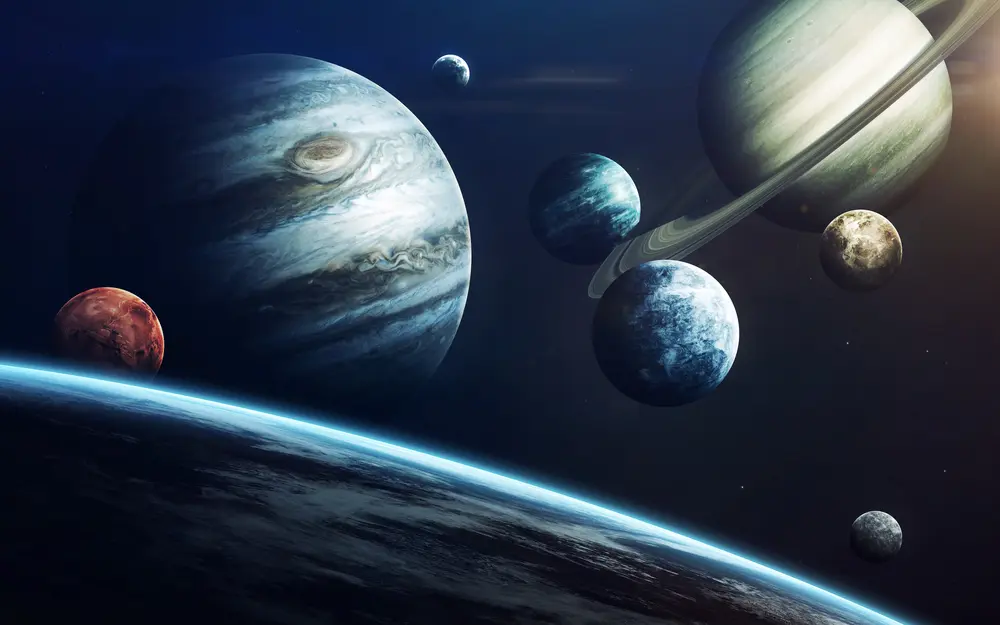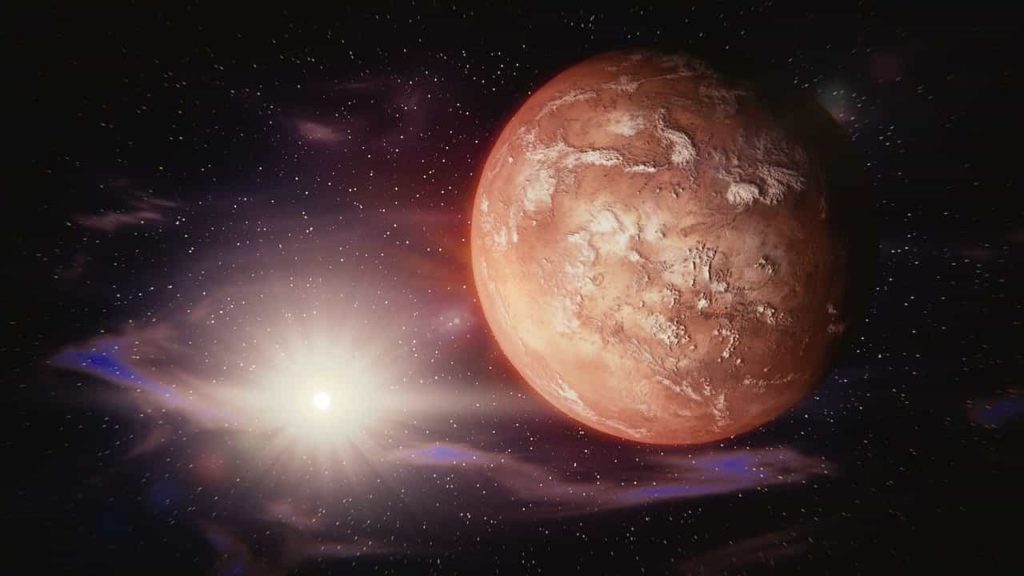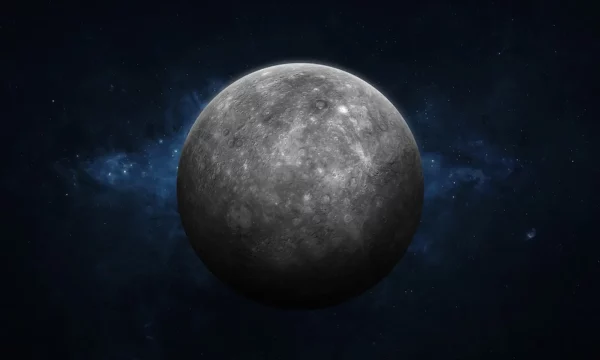
Meet Mercury - The Smallest Planet in The Solar System
Last Updated: September 19, 2023
When considering the planets, Mercury is often the last to come to mind, unless you’re listing them off in order from the Sun. It isn’t very photogenic, lacking the expansive rings, storms, or bright colors that can be spied on other worlds in our neighborhood.
It often looks like a less exciting version of our Moon, unless NASA has color-coded the image displaying different elements in its surface. It’s not even the hottest planet in the solar system. But Mercury has both mysteries and answers to questions that speak to the heart of our existence. Let’s dive into the closest planet to the Sun.
Introduction to Mercury
Despite all the descriptions of what it’s not, Mercury does hold several titles. This closest planet to the Sun is small but swift, with the fastest orbit in the solar system.
Despite what you may think, Mercury is visible to the naked eye and was therefore known by the ancients like Venus, Mars, Jupiter, and Saturn. It was observed with the newly invented telescope in 1631 by Thomas Harriott and Galileo Galilei and Pierre Gassendi used the telescope to watch the planet transit the Sun that same year. We’ll discuss observing Mercury more later in this guide.
Mercury also poses many interesting situations and questions, which scientists and researchers seek to answer through various studies including:
- Understanding our Sun and how it ages
- The orbits of the planets are slowly expanding as the Sun’s gravitational forces gradually weaken as the star ages and loses mass.
- Studying the changes in Mercury’s orbit has helped us to indirectly measure the loss of the Sun’s mass.
- Understanding how Mercury formed
- There are still many unsolved mysteries about Mercury’s formation
- Understanding the formation of the early solar system, particularly of terrestrial planets
- Its composition and structure provide clues about the birth of our solar system and terrestrial planets like ours
- Understanding the effect of intense solar radiation and solar wind on a planetary body
- While we would likely never be able to colonize Mercury due to its extreme, inhospitable environment, including but not limited to intense solar radiation, it helps us provide a real-life example in simulations of exoplanets that are closer to their star than Earth is to the Sun.
- Observing space weathering on Mercury from being bombarded by stellar radiation and high-energy particles helps us better understand how these factors impact other bodies like the Moon and asteroids.
- Understanding historical and active geological processes
- Mercury features both old and new geological formations, providing unique insights into how these processes occur over time and impact a planet.
- Understanding extreme temperature effects
- The drastic yo-yo effect of hot and cold on Mercury’s surface from the close proximity of the Sun and lack of an atmosphere helps us to better understand how materials react under extreme conditions and the thermal evolution of rocky planets.
Physical Characteristics
Together, let’s explore what Mercury is like. What does it look like? How does it compare to Earth?
Size, mass, volume, and density
Mercury is small with an equatorial circumference of 9,525.1 miles (15,329.1 km), a little more than 1/3 the width of Earth or only slightly larger than Earth’s Moon. It is the closest planet to our Sun at an average distance of 36 million miles (58 million kilometers or 0.4 AU).
Its volume is about 14.6 billion miles cubed (60 billion km cubed) compared to our 260 billion miles cubed (1.08 trillion km cubed). Our densities are similar with Mercury being 5.427 g/cm cubed versus Earth’s 5.513 g/cm cubed.
Its gravity is about 38% of ours and its mass is about 3.285 × 10^23 kg compared to Earth’s 5.97219 × 1024 kilograms.
What is the surface like?
Mercury’s surface is much like the Moon’s: scarred by impact craters from collisions with meteoroids and comets (many of these are named after famous deceased artists, musicians, and authors including Dr. Seuss and dance pioneer Alvin Ailey).
While there are large smooth areas, there are cliffs, some hundreds of miles long and up to a mile high that rose as the interior of the planet cooled and contracted over its lifetime. You can access a detailed terrain map of Mercury with labeled features here. Other odd terrain features include hollows/ depressions ranging from 60 feet to over a mile across and 60-120 feet deep, crater impact zones like Van Eyck and Abedin, volcanic vents, and the spider troughs around the Apollodorus crater.
The hollows are particularly interesting as they appear to have appeared fairly recently and suggest the volatile materials from the interior of Mercury have been evaporating into space, leaving behind these features. Measured changes in these features can help to add further evidence and determine the ultimate answer to whether or not Mercury is still tectonically active.
Most of the surface would appear greyish-brown to the human eye, but there are bright streaks called “crater rays”. These are formed when an asteroid or comet strikes the planet, digging a hole in the ground from the massive amounts of energy released and crushing rock at the point of impact, which is then thrown far from the crater, forming the rays since fine particles of crushed rock are more reflective than large pieces. The rays will darken over time thanks to dust impacts and solar wind particles.
Fun Fact: as a whole, the planet appears darker than expected, only reflecting about 2/3s as much light as the Moon. The cause and reason for this are still a mystery, but further measurement of the distribution of the minerals on the surface may shed some light, such as the possibility of graphite-rich layers.
What about its atmosphere?
Mercury doesn’t have a true atmosphere, but it does have a thin exosphere made up of atoms and ions from solar wind and when these materials are blasted off the surface by polar wind and meteoroid strikes. The weak gravity and close proximity to the Sun it can’t retain a true atmosphere.
The exosphere is composed mostly of oxygen (O2), sodium (Na), hydrogen (H2), helium (He), and potassium (K). MESSENGER’s Ultraviolet and Visible Spectrometer revealed that the presence of magnesium and calcium in the exosphere is higher at Mercury’s dawn, implying that meteoroid impacts are more frequent on whatever side of the planet is experiencing dawn.
Fun Fact: Mercury has a magnetic field… but it’s weird
Mercury does have a magnetic field, which is surprising, making it the only other terrestrial planet to currently have one (Mars used to, but lost it). Mercury should be too small to have one but it does, even though it is just 1% the strength of Earth’s and offset about 400 km relative to the planet’s equator (in contrast to Earth’s magnetic field which is centered in the middle).
Magnetic field interactions with solar wind.
Solar wind is a stream of charged particles (primarily protons and electrons) emitted by the Sun which then interacts with Mercury’s magnetic field, thin exosphere, and surface in a variety of ways. When solar wind interacts with Mercury’s relatively weak magnetic field, it forms a magnetosphere around the planet, but much smaller and less pronounced than ours.
The shape and size of the magnetosphere can fluctuate based on the interactions between the solar wind and Mercury’s magnetic field. As the solar wind approaches Mercury, it compresses the magnetic field, creating what is known as the magnetopause which is the boundary where the pressure from the solar wind balances the pressure of Mercury’s magnetic field. The solar wind is slowed down and deflected around Mercury’s magnetosphere at the bow shock, a curved region in front of the planet.
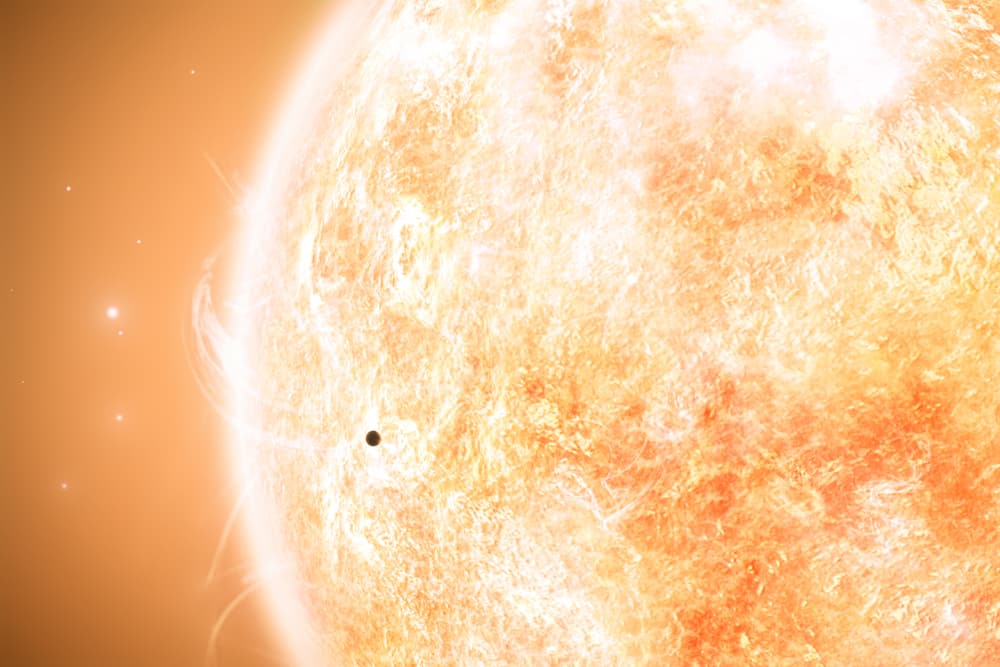
Is there water?
Mercury certainly doesn’t have the beautiful blue oceans of Earth, but evidence suggests the presence of water ice at its north and south poles inside deep craters that are in permanent shadows as they are cold enough to preserve the ice. However, direct measurements have not been performed yet.
Can I explore the surface of Mercury?
Yes! Check out the resources below:
NASA 3D model: https://solarsystem.nasa.gov/resources/2369/mercury-3d-model/ (might be cool to either link to or even embed since I believe it should be fair use)
NASA Eyes on Solar System is also a good tool for exploring its surface, comparing its size, and more.
USGS Detailed and Labeled Feature Map: https://www.usgs.gov/media/images/mercurymapwithfeaturespng
Days and Years or Rotation and Orbit
Compared to Earth’s fairly circular orbit, Mercury’s orbit is highly eccentric and egg-shaped, meaning although its average orbit is 36 million miles from the Sun, it is 29 million miles (47 million kilometers) away at its closest point in the orbit and 43 million miles (70 million kilometers) at its furthest.
From its surface, the Sun would appear over 3 times as large as we view it from Earth and the light would be up to seven times brighter. Zipping around the Sun every 88 days it is the fastest planet in the solar system, traveling at almost 29 miles (47 kilometers) per second. However, the planet spins slowly on its axis, completing a rotation every 59 Earth days.
However, when Mercury is moving the fastest in its orbit and is closest to the Sun, the Sun’s movements get a little wonky and each rotation is not accompanied by sunrise and sunset. The morning Sun appears to rise briefly, set, and rise again from parts of the planet’s surface, and the same happens in reverse at sunset for other parts of the surface.
Fun Fact: Due to these weird mechanics, one full-day night cycle or solar day actually equals 176 Earth days, which at 88 days per orbit around the Sun means it is technically over 2 years on Mercury, creating a unique 3:2 spin-orbit resonance. This was only discovered using radar in 1965. We had previously believed that it was tidally locked around the Sun with the same side always facing the Sun.
Orbital parameters describe the way objects move around in space, such as planets, moons, and satellites. These parameters include the size, shape, and tilt of the orbit, as well as the object’s position and speed within the orbit.
| Property | Definition | Mercury | Earth | Ratio (Mercury/Earth) |
|---|---|---|---|---|
| Semimajor axis (106 km) | The longest radius of an elliptical orbit | 57.909 | 149.598 | 0.387 |
| Sidereal orbit period (days) | The time it takes for the planet to complete one full orbit around the Sun, as observed from the stars | 87.969 | 365.256 | 0.241 |
| Tropical orbit period (days) | The time it takes for the planet to go from one vernal equinox to the next | 87.968 | 365.242 | 0.241 |
| Perihelion (106 km) | The closest distance from the planet to the Sun during its orbit | 46.000 | 147.095 | 0.313 |
| Aphelion (106 km) | The farthest distance from the planet to the Sun during its orbit | 69.818 | 152.100 | 0.459 |
| Synodic period (days) | The time it takes for a planet to return to the same point in its orbit as observed from Earth | 115.88 | – | – |
| Mean orbital velocity (km/s) | The average speed of the planet along its orbit | 47.36 | 29.78 | 1.590 |
| Max. orbital velocity (km/s) | The maximum speed of the planet along its orbit | 58.97 | 30.29 | 1.947 |
| Min. orbital velocity (km/s) | The minimum speed of the planet along its orbit | 38.86 | 29.29 | 1.327 |
| Orbit inclination (deg) | The tilt of the planet’s orbit relative to the ecliptic plane | 7.004 | 0.000 | – |
| Orbit eccentricity | The measure of how much the planet’s orbit deviates from a perfect circle | 0.2056 | 0.0167 | 12.311 |
| Sidereal rotation period (hrs) | The time it takes for the planet to complete one full rotation on its axis, as observed from the stars | 1407.6 | 23.9345 | 58.785 |
| Length of day (hrs) | The time it takes for the planet to rotate once on its axis relative to the sun (sunrise to sunrise) | 4222.6 | 24.0000 | 175.942 |
| Obliquity to orbit (deg) | The angle between the planet’s rotational axis and its orbital axis | 0.034 | 23.44 | 0.001 |
| Inclination of equator (deg) | The angle between the planet’s equator and the plane of its orbit | 0.034 | 23.44 | 0.001 |
Formation and Geology
When studying the other planets, we better understand how Earth came to be and why it might have formed differently than the other bodies to create what we see today.
How did Mercury form?
Mercury was formed about 4.5 billion years ago, like the other planets when particles of gas, dust, and larger rock collected together due to gravitational forces and the centrifugal force of the young Sun’s gravity.
As with many other planets (not just Saturn!), Mercury has a dust ring made up of some of the leftover building blocks of this early solar system period, but it’s a little different. Scientists describe a haze of cosmic dust over Mercury’s orbit, a ring about 9.3 million miles wide that Mercury, at 3,030 miles wide, wades through.
But there are many questions and mysteries regarding Mercury’s formation, such as where it originally formed.
Despite the fact that planets that form closer to the Sun usually have more thorium (as the stable radioactive element survives in very high temperatures) than potassium which is more volatile and evaporates quickly in a hot environment, Mercury has too much potassium compared to thorium. In fact, Mercury’s ratio of the two elements is closer to that of Mars than the ratio measured on Earth, the Moon, and Venus.
This could mean that it formed closer to Mars and then was moved to its present-day location by a collision or it could simply be that a powerful impact created Mercury’s unusual formation including its interior.
What is inside Mercury? Is it similar to Earth?
Mercury’s interior is similar to Earth, but also very different. It does have the same basic three components, a core, mantle, and crust:
- Large solid metallic iron inner core with a radius of about 1,289 miles (2,074 kilometers) very nearly the same size as Earth’s inner core (about 1,500 miles or 2,400 kilometers), filling nearly 85 percent of the planet’s radius and volume. Fun Fact: This solid inner core makes up about half of Mercury’s entire core (about 2,440 miles, or nearly 4,000 kilometers, wide); this massive inner core compared to the other rocky planets in our solar system is one of the most intriguing mysteries of Mercury. The rest of the core must be at least partially molten since Mercury has a magnetic field.
- One of the current theories is that at least one (but more likely one head-on hit versus a rain of impacts) collision early in its life stripped away the planet’s outer layers, leaving the core to dominate its structure. The MESSENGER mission helped scientists to measure its interior based on its spin and gravitational forces as the orbiter got closer and closer to the surface of the planet, but questions still remain.
- Mantle: the silicate mantle composed of rocks rich in magnesium and iron are similar to the mantle of Earth, but much smaller.
- Mercury’s outer shell, comparable to Earth’s outer shell (called the mantle and crust), is much thinner at only about 400 kilometers (250 miles) thick. While the exact composition of the crust is still being studied, it mainly appears to consist of silicate minerals like basalt and pyroxene.
The current understanding of planetary formation is they start hot, almost completely molten, and as they cool, minerals crystalize, some of them separating to form different layers inside the planet. Our Moon shows these layers in samples. Earth, however, does not show this mineral separation possibly because of our tectonic activity of magma under surface plates which mixed everything up.
We had long wondered if Mercury’s interior showed mineral separation or not. 2016 studies showed that a layered mantle would not be needed as a homogenous interior could bring a variety of melted materials from different depths to the surface, explaining the heterogenous composition of the surface. Older terrains have formed from material melting deep between the boundary of the core and mantle while younger terrains formed much closer to the surface.
In particular, the sulfur dissolves into the silicate mantle and influences the melting of materials which combined with the pressure, create the heterogenous surface we see today. This study also showed that Mercury, like Earth and the Moon, could have formed from similar materials (enstatite chondrites) as opposed to diverse materials as had previously been theorized. Exactly how the mantle became homogenized is still being studied.
Fun Fact: Mercury appears to be tectonically active and is even shrinking!
Mercury appears to be the only other tectonically active planet in our solar system besides Earth, showing changing landscapes and even volcanic activity over the years.
In fact, it’s shrinking or contracting as part of its tectonic activity, evident through new features like fault scarps (cliff-like features resembling stair steps) small enough that they must be young geologically in contrast to the larger scarps found during the MESSENGER mission.
These scarps formed as the planet’s interior cooled, contracting the planet and causing the crust to break and thrust upward along faults into cliffs up to hundreds of miles long and even up to over a mile high. This tectonic activity is caused by the global magnetic field that has existed for billions of years and the slow cooling of Mercury’s still-hot outer core, potentially even causing “Mercury-quakes”.
However, further evidence of changes in these features will help prove that it is still tectonically active today.
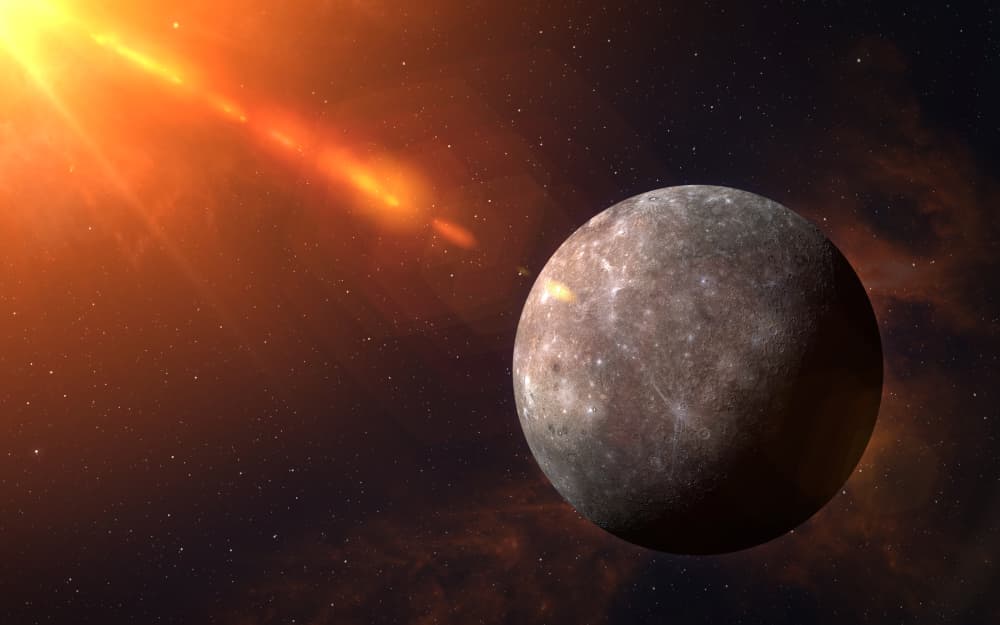
Interesting Topography
Due to this tectonic activity and the bombardment of meteoroids from space, the surface features many interesting areas that map out its history. Very large impact basins, including Caloris (960 miles or 1,550 kilometers in diameter) characterized by a set of concentric rings and ridges and Rachmaninoff (190 miles, or 306 kilometers in diameter), were created by asteroid impacts on the planet’s surface early in the solar system’s history. Caloris in particular shows evidence of past volcanic activity and a volcanic layer 1.6-2.2 miles (2.5-3.5 km) thick. Caloris is relatively low in magnesium and silicon.
Climate
Due to its extreme conditions, Mercury’s weather and what could be called a climate are interesting.
Fun Fact: Mercury may not be the hottest planet in the solar system, but it does have the most extreme temperature fluctuations!
Despite being the closest planet to the Sun, it is not the hottest planet in the solar system thanks to Venus’s dense atmosphere which traps heat and has created a runaway greenhouse effect as well as an average temperature of about 867°F (464°C).
In contrast, Mercury has no atmosphere and therefore no way to trap the heat it receives from the Sun which is then dissipated into space as soon as it turns away from the Sun and into night. Therefore, Mercury’s dayside temperatures can reach 800°F (430°C), but the nightside temperatures drop to -290°F (-180°C), creating an average temperature of 333°F (167°C).
Day and Night Effects on Climate
The day-night cycle of Mercury creates drastically different temperatures and the exosphere provides little to no temperature and weather regulation. Due to this and its slow rotation, Mercury does not experience distinct seasons or weather patterns with minimal localized variations due to surface topography. Without an atmosphere and liquid water, weather related to water is nonexistent.
What about seasons?
Mercury’s axis is tilted just 2 degrees, meaning little to no seasonal variations.
Solar wind “weather”
The solar wind particles that manage to cross the magnetosphere bow shock can collide with the exosphere and surface. Solar wind that reaches the surface of Mercury erodes and moves surface materials, especially in areas not protected by the magnetic field such as the poles.
Interactions between the magnetic field and the solar wind sometimes even create intense magnetic tornadoes, funneling fast, hot solar wind plasma to the surface. When the ions in the solar wind impact, they knock off neutrally charged atoms and loop them high into the sky.
Exploration of Mercury
Direct exploration of Mercury has been limited for a number of reasons. Traveling to Mercury is relatively difficult despite its relatively close distance compared to the outer solar system bodies. This is because the impact of the Sun’s gravity increases as you get closer to it, requiring more caution in maintaining speed and stopping when we reach Mercury.
In addition, any probes must be shielded against the intense solar radiation and temperatures that exist in Mercury’s orbit. Due to this, only three missions have been launched to Mercury, with the most recent occurring in 2018. Below you can see some of the details from these missions.
| Mission Name | Destination | Mission Log Dates | Notes |
Mariner 10 (NASA) Flyby | Mercury | Launch: Nov 3, 1973 | 1st mission to visit Mercury; goal was to study the atmosphere (if any), surface and other physical characteristics; Conducted three flybys of Mercury |
| Jamuary 1974: Equipment Test | Successfully returned data on Comet C/1973 E1 Kohoutek, the first time a spacecraft returned data on a long-period comet. | ||
| Feb. 5, 1974: closest flyby of Venus at 3,584 miles (5,768 kilometers) | 1st picture detailed the day-night terminator 4.165 total photos and other data | ||
| March 29, 1974: 1st flyby of Mercury with closest encounter of 437 miles (703 kilometers) | Showed a very moon-like surface with craters, ridges, and chaotic terrain Magnetometers revealed a weak magnetic field Recorded nighttime temperatures of -297 Fahrenheit (minus 183 degrees Celsius) and maximum daytime temperatures of 369 degrees Fahrenheit (187 degrees Celsius) Readings indicated a lack of atmosphere or ionosphere | ||
| April-Sept 1974: Course corrections toloop around the Sun and back | |||
| Sept. 21, 1974: 2nd flyby of Mercury at a range of about 29,869 miles (48,069 kilometers) | Imaged southern polar region Used solar pressure on its solar panels and high-gain antenna for attitude control | ||
| Oct. 1974-March 1975: Course corrections for third and final encounter with Mercury | |||
| March 16, 1975: 3rd and closest flyby of Mercury at a range of about 200 miles (327 kilometers) | Due to technical issues, only the central quarter of each of 300 high-res photos were received | ||
| March 24, 1975: last contact | Spacecraft exhausted fuel for attitude cotnrol | ||
| End: Mar 24, 1975 | 1st spacecraft to Mercury First spacecraft to explore 2 planets (mercury and Venus) during a single mission 1st spacecraft to use a gravity assist to change its flight path First to return to its target after an initial encounter First to use solar wind as a major means of spacecraft orientation during flight Imaged about 45% of the surface and returned over 2,700 images throughout the 3 flybys, some of which showed details as small as 328 feet (100 meters) wide | ||
MESSENGER (NASA) Orbiter | Mercury | Launch: Aug 3, 2004 | 1st mission to orbit Mercury; goal was to study the geology, magnetic field, and chemical composition of the planet; flew by Mercury three times and orbited the planet for four years; launch sent itinto an initial parking orbit around Earth and then accelerated into an escape trajectory into an orbit around the Sun |
| MEcury Surface Space ENvironment GEochemistry and Ranging | Flyby of Earth (Aug. 2, 2005) Two flybys of Venus (Oct. 24, 2006, and June 5, 2007) | Allowed mission controllers to properly calibrate instruments by capturing images of the Earth-Moon system Allowed the spacecraft to overcome the problem of massive acceleration that accompanies flight toward the Sun Venus flybys allowed the spacecraft to record an immense amount of data, coordinating with ESA’s Venus Express Mission | |
| From Mercury, “Messenger of the gods” | 2008-2009: three flybys (Jan. 14, 2008, Oct. 6, 2008, and Sept. 29, 2009) | helped to decelerate MESSENGER’s velocity relative to Mercury and also helped conserve propellant for its orbital mission (although it prolonged the length of the trip) | |
| Feb. 18, 2011 | Mosaic of the solar system minus Uranus and Neptune | ||
| March 18, 2011: enters orbit and begins orbital mission at Mercury | Began official data collection April 4 Revealed its geological history and verified its polar deposits are mainly water-ice (as opposed to ices of other elements) Initial discoveries: high concentrations of magnesium and calcium on the nightside, identifying northward offset of magnetic field from center, finding large amounts of water in the exosphere, and finding evidence of past volcanic activity on the surface Took nearly 100,000 images of the surface | ||
| March 17, 2012: completes primary mission, begins extended mission | |||
| April-May 2012: reduced orbital period to 8 hours | Took its 100,000th image from orbit, globally mapping both in high-res monochrom and in color, the entire surface of the planet During this first extended mission, the spacecraft found evidence suggesting the presence of water ice at Mercury at the poles in locations that never see sunlight Second mission extension granted to March 2015 | ||
| Feb. 6, 2014: 200,000 orbital image | Far exceeded original expectation of at least 1,000 photographs During second extension, photographed Comet 2P/Encke and Comet C/2012 S1 (also known as Comet ISON). | ||
| Summer 2014 | Began moving to a very low orbit for new research | ||
| Fall 2014- Jan 2015: orbital maneuvers to continue its scientific observations | |||
| End: Apr 30, 2015, plunging into Mercury’s surface | Impacted the planet’s surface at about 8,750 miles per hour (14,080 kilometers per hour), creating a new crater on Mercury at 54.4 degrees north latitude and 149.9 degrees west longitude, near the Janácek crater in Suisei Planitia Other notable finds from the mission: a higher than expected prevalence of volatile materials like potassium (especially in relation to throrium); dents or hollows that appear to be caused by interior materials evaporating recently | ||
BepiColombo (ESA/JAXA) Double Orbiter | Mercury | Launch: Oct 20, 2018 | Will study Mercury’s composition, structure, magnetic field, and exosphere to better understand its formation, current characteristics, and these impacts on our understanding of the formation of the early solar system including that of Earth |
April 13, 2020: Earth flyby Oct. 16, 2020: Venus flyby Aug. 11, 2021: Venus flyby Oct. 1, 2021: 1st Mercury flyby June 23, 2022: Mercury flyby June 20, 2023: Mercury flyby Sept. 5, 2024: Mercury flyby Dec. 2, 2024: Mercury flyby Jan. 9, 2025: Mercury flyby Dec. 5, 2025: Mercury orbital insertion | Two spacecraft riding together to Mercury to orbit and to study the planet from unique vantage points ESA’s and JAXA’s first mission to Mercury 1st mission to Mercury comprised of 2 orbiters ESA main spacecraft Mercury Planetary Orbiter (MPO) to study surface and internal composition of planet JAXA Mercury Magnetospheric Orbiter (MIO) to study the magnetosphere (region of space that is dominated by its magnetic field) Primary science mission begins in early 2026 |
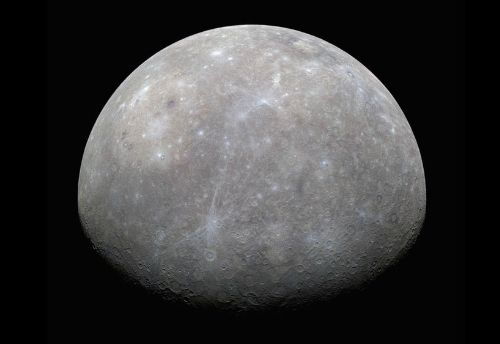
Mercury in Popular Culture
Mercury itself is named after the Roman god Mercury. You may be more familiar with his Greek counterpart, Hermes, the messenger of the gods. They are both known for being the swiftest of their respective deities, which fits the swiftest planet in the sky.
In addition to being the swiftest of the gods, Mercury is the god of commerce, financial gain, messages and communication, travel, and thievery, as well as the guide of souls to the underworld.
Certain versions of his birth depict him as the son of Jupiter and Maia, one of the seven daughters of Atlas who holds ups the skies, while others depict him as the son of Caelus, a primal god of the sky, and Dies, the personification of the day.
Like many of the other planets, Mercury has had an impact on much of popular culture including literature, film, television, and other media.
- Literature: The first official recorded instance of Mercury as a setting in fiction was “L’Adone” by Giambattista Marino in 1622. The first English-language piece set primarily on Mercury was the 1905 novel Adrift in the Unknown, or Adventures in a Queer Realm by William Wallace Cook. Mercury received the most attention in fiction works when it became better studied, primarily when it was incorrectly believed to be tidally locked with a permanent dayside and nightside (from 1893-1965), creating an intriguing setting for sci-fi writers. Examples include the 1930 Tama of the Light Country by Ray Cummings, multiple short stories by Isaac Asimov (i.e. “Runaround” and “The Dying Night”), and Kurt Vonnegut’s 1959 novel The Sirens of Titan. Despite the correction in the scientific field in 1965, many science fiction authors continued to use the tidally locked Mercury as a setting, such as Kim Stanley Robinson in The Memory of Whiteness. Although Mercury as a destination in science fiction has died down, it has been represented as a base for studying the Sun such as in the 1980 novel Sundiver by David Brin, or utilized for other resources such as solar power (2005 novel Mercury, by Ben Bova). Arthur C. Clarke features descendants of human colonists on Mercury in his 1973 novel Rendezvous with Rama.
- TV and Film: While Mercury continues to be underrepresented in TV and film, there are a few standouts. In 1955, it was featured in a few episodes of “Commando Cody: Sky Marshall of the Universe”. It was featured in the animated “Invader Zim” where it is turned into a giant spaceship as well as in the Doctor Who universe. It was also featured in the 2007 movie Sunshine where a spacecraft orbits Mercury to rendezvous with another spacecraft. There was a 2011 TV Movie called Collision Earth where structural changes in the Sun throw Mercury out of orbit and set it on a collision course with Earth. It continues to be featured in documentaries as well as educational TV shows like The Magic School Bus and Schoolhouse Rock.
- Comics: In “Calvin and Hobbes”, Calvin and Susie have to give a presentation on the tiny planet, leading to Calvin providing questionable information such as that he’s the god of flowers and bouquets as well as a registered trademark of FTD florists. Mercury also often appears in comic science fiction series like “The Flash” and “Green Lantern”. Wonder Woman and other DC characters like Johnny Thunder and Atom Blake have had adventures on Mercury.
- Video Games: Mercury is a common destination for space exploration and science fiction in gaming such as Blast Corps, Buck Rogers: Countdown to Doomsday, Star Control II, the “Mass Effect” series, “Destiny 2”, and Network E.L.E.
- Music: Various songs (“Mercury” by Steve Lacy and GHOSTEMANE), band names (The Band Mercury), musician names, studios (Mercury Studios under Univeral Music Group) record companies (Mercury Records), and music prizes (the annual Mercury Music Prize for the best album released in the UK by a British or Irish act) have been influenced by the planet as well as its namesake. The frontman for the famous band Queen changed his surname to Mercury as a reference to a line in a previous song of his called “My Fairy King” which references Mother Mercury. Although there is no consistent answer on the origin of their band name (ranging from an imaginary Russian ballet dancer to a sharp rise in temperature, or a revved-up auto) the band Mercury Rev also clearly takes its name from something related. The terraforming of Mercury is shown in the 2000 self-titled album Deltron 3030.
The name Mercury is possibly related to the Latin words “merx” (as in merchandise, merchant, etc.), “mercari” (to trade), and “merces” (wages) as well as the Proto-Indo_European root “merg-” for boundaries or even “keeper of boundaries” in Greek.
It has also been applied to other fields such as the element mercury which is the only metal on Earth that is liquid at room temperature and has been known since ancient times such as uses in alchemy and medicine in Egypt dating to 1500 BCE.
It is known for being extremely slippery, sliding off objects and even human skin easily despite being so heavy that 2 tablespoons of it weigh about a pound. There is a Marvel comic book character of the same name who has powers related to the element. We also use it to describe a person who is known to be prone to sudden and unpredictable mood changes that easily influence decisions (mercurial).
Observing Mercury in the Night Sky
Due to its close proximity to the Sun, it can be difficult to directly observe Mercury from Earth as its brightness outshines the tiny planet. Predawn and twilight hours are the typical viewing times for Mercury. It will be along the horizon when astronomical twilight ends in the evening and just clearing it in the morning and will never be particularly high in the sky since if it is, the Sun is also and therefore blocking it.
Due to the thicker atmosphere near the horizon that is more susceptible to atmospheric turbulence, Mercury often looks more like a star than a planet, shimmering or twinkling.
Mercury can be viewed with your naked eyes, but a pair of low-powered binoculars can make spotting it quickly much easier and in much better detail as soon as the Sun dips safely below the horizon. A small telescope, ideally with GoTo and tracking features to help keep the tiny swift planet within view during your observation without manual adjustments, can bring even more of its details to light. It’s too small for its craters to become visible, but you can see some larger terrain details on its surface. If the telescope has a solar filter and is in the shade, you can view it during the day.
In planetary observing, there are a couple of terms that are important to remember since we have to consider the location of the desired planet, the Sun, and the Earth to understand how and when the planet will be visible and how. First, astronomers typically group the planets into two subsets to determine their viewing schedule:
Superior Planets: those past Earth going away from the Sun meaning Mars and beyond
Inferior Planets: the two planets closer to the Sun than the Earth (Mercury and Venus)
Then we look at the location of the desired planet, Earth, and the Sun with a few line-ups that determine their visibility:
Opposition occurs when a planet is directly opposite the Earth from the Sun meaning that they line up with the Earth between the Sun and the other planet. This is typically the best time to view the planets as it is when they will appear the brightest since the planet is the closest to Earth and fully illuminated by the Sun. Only superior planets experience oppositions while inferior planets experience 2 conjunctions.
Conjunctions occurs when a planet is directly in line with the Sun from the Earth meaning the Sun lies directly in between the 2 planets for superior planets. For inferior planets, like Mercury, we see the following interactions.
- Superior Conjunction is when the planet is on the opposite side of the Sun from the Earth (behind the Sun from our perspective). The planet appears as a full disk like a full Moon, but smaller since it is further away.
- Inferior Conjunction is when the planet is on the same side of the Sun as the Earth, meaning they are in front of the Sun from our perspective. The planet disappears as a new Moon and as a large thin crescent just before and after.
- Greatest Elongation is when the planet is at its greatest observed angle between it and the Sun when viewed from the Earth. It appears as a half circle like a first or third quarter Moon. This occurs both in the eastern and western sky. Greatest Elongations are the best and safest time to observe Mercury. Otherwise, it is too close to the Sun and you can harm your eyes by staring close at the Sun. Make sure that you have a solar filter on telescopes or binoculars to protect yourself.
In between the conjunctions, Mercury waxes and wanes like our Moon and appears higher or lower in the sky. When Mercury moves from Superior conjunction (behind the Sun), it travels left/ east relative to the Sun and begins to rise in the western horizon before sunset, continuing to appear higher in the sky each night, and going through the waning phases (growing smaller and smaller from the fully illuminate disk at superior conjunction). It eventually reaches its greatest easter elongation and appears as a half circle near its peak height in the evening sky. It continues closer to Earth, lower in the sky as a crescent.
It then reaches inferior conjunction in front of the Sun similar to a new moon before waxing (growing) into a crescent again as it moves to the right/ west relative to the Sun and rises in the eastern horizon before sunrise. At its greatest western elongation, it appears as a half circle, again near its peak height in the morning sky. As it moves further away from the Earth, it becomes dimmer and continues through the waxing phases until it is again at superior conjunction, beginning the cycle once again.
Upcoming greatest western elongations (best morning visibility):
- September 22, 2023
- January 12, 2024
- May 9, 2024
- September 5, 2024
- December 25, 2024
Upcoming greatest eastern elongations (best evening visibility):
- August 10, 2023
- December 4, 2023
- March 24, 2024
- July 22, 2024
- November 16, 2024
We also use the word conjunction to describe when planets line up with each other or the Moon in the night sky, making them easier to spot.
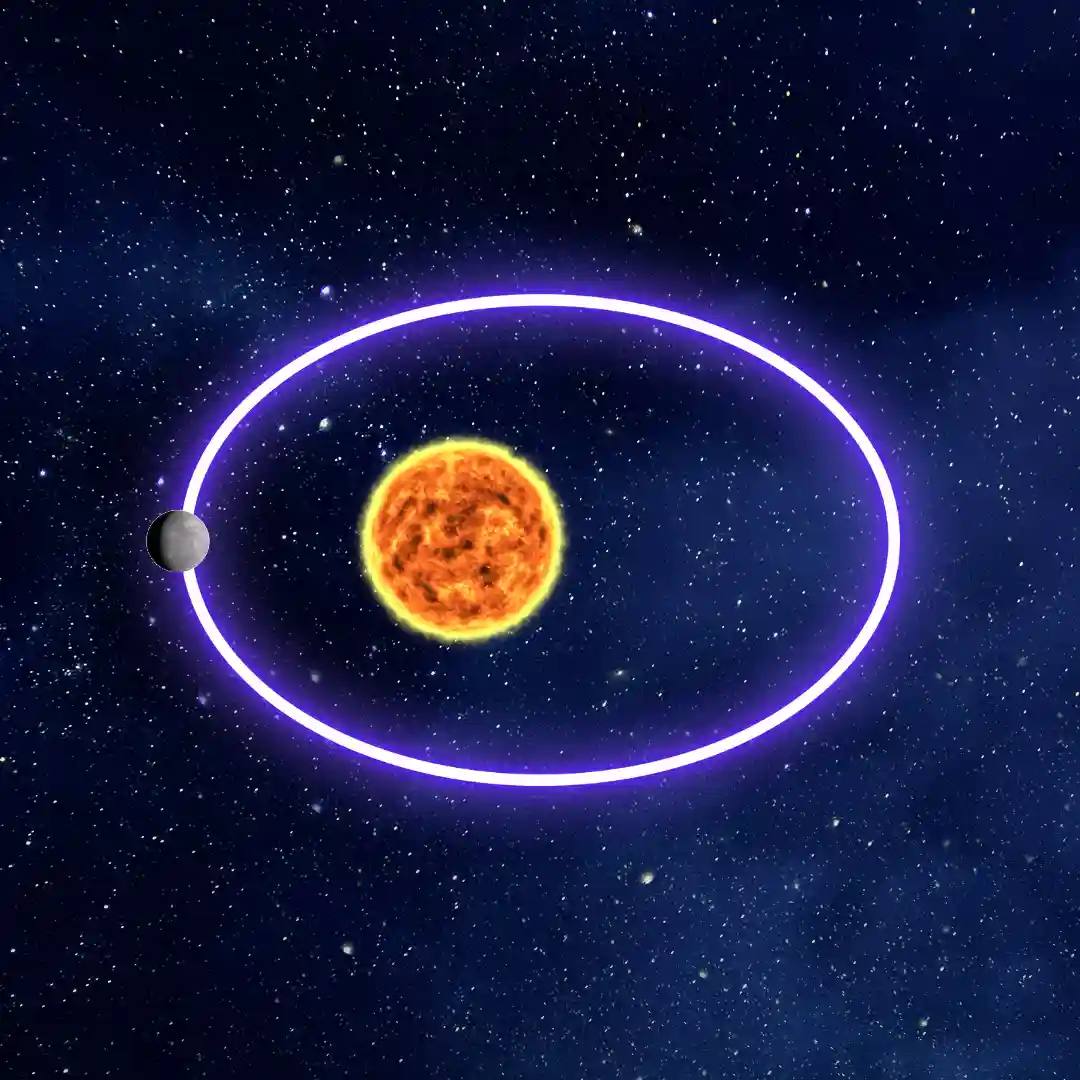
Upcoming 2023 conjunctions with other planets:
- July 27: Mercury and Venus will be very close to each other in the constellation of Leo (follow the tip of the hook of the coathanger asterism down and to the left), but difficult to observe in the Northern Hemisphere due to being too close to the Sun. Observers in the Southern Hemisphere will have a dark enough sky to observe them.
- August 13: Mercury and Mars will meet in the constellation of Leo, relatively high in the sky. Look in the evening about an hour after sunset.
**Note: March 2023 featured three Mercury conjunctions with other planets including Saturn, Neptune, and Jupiter while May featured an additional Jupiter conjunction.**
13 times a century, Mercury will pass in front of Earth at the right time so that observers on Earth see it pass across the Sun as a shadow called a transit in early May and November when they occur. Past Mercury transits: May 7, 2003, Nov. 8, 2006, May 9, 2016, and Nov. 11, 2019. The next Mercury transit: November 12/13, 2032. Solar telescopes are needed to view transits.
Summary and Future Prospects
Mercury is still a fascinating world, despite often not receiving attention. As the closest planet to the Sun, it continues to reveal information about our star including its mass and radiation as well as help us understand planetary formation in extreme environments.
As a terrestrial body in our solar system with a unique formation, it continues to reveal information about the early solar system and the formation of terrestrial planets, especially those close to the Sun. As the only other tectonically active planet in our solar system, it continues to help us understand geological processes.
While the past Mariner 10 and MESSENGER missions have revealed information about this planet, the current BepiColumbo is already completing flybys and transmitting data, with orbital insertion planned for December 2025 after three more flybys. This mission will help us to explore and better understand Mercury’s composition, structure, magnetic field, and exosphere which will have lasting impacts on our understanding of the early solar system, rocky planet formation, and our Sun.
In particular, BepiColumbo plans to shed some light on Mercury’s mysterious formation, confirm the presence of water on the planet through direct measurement, confirm whether the planet truly is tectonically active by finding changes in hollows and other features, determine why it’s so dark, and determine why it has a magnetic field despite the fact that it shouldn’t.

Sarah Hoffschwelle is a freelance writer who covers a combination of topics including astronomy, general science and STEM, self-development, art, and societal commentary. In the past, Sarah worked in educational nonprofits providing free-choice learning experiences for audiences ages 2-99. As a lifelong space nerd, she loves sharing the universe with others through her words. She currently writes on Medium at https://medium.com/@sarah-marie and authors self-help and children’s books.
Wow! There's more to read 🚀
This page is part of our collection of astronomy articles. If you enjoyed the read, then you’ll love the following articles.

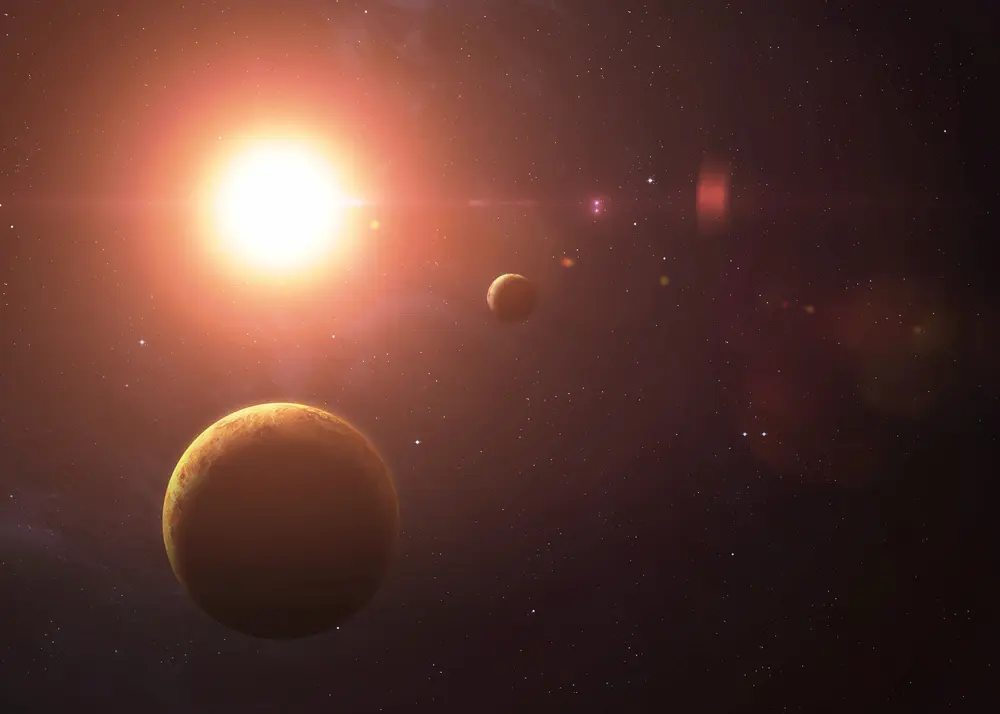
Mars is among the most popular planet to observe in the night sky. Here are a few tips and tricks on observing Mars through a telescope.
